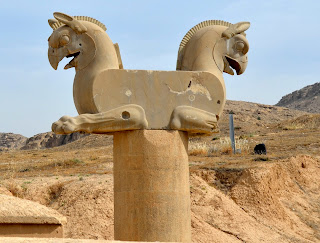May 8, 2016
Blog
8: PERSEPOLIS, PALACES, TOMBS & MOSQUES
Persepolis
Situated 60 kilometers north of Shiraz
is Persepolis, which translated means the “Persian City”. It is the ceremonial
capital of the Achaemeinid Empire (550-330BC) and is a World Heritage
Site. It includes a terrace as
well as four tombs cut in the side of the mountain while the other three sides
are framed by a limestone retaining wall.
Andrea Godard, a French archaeologist excavated this site in the early
1930s; it is believed that it was Cyrus the Great who originally chose the site
and then Darius I who built the terrace and palaces. This remote place became the
capital of Iran with a residence, Treasury, and stairway known as the
Persepolitan Stairway built on the western side of the Great Wall with 111
steps.
 |
Our guide and others heading for the stairway to Persepolis
|
 |
| It's hot! |
 |
111 Stairs to climb first

 |
Huge Limestone blocks

Later I see a group of school children arriving at the site and rushing to the top.
|
 After invading Achaemenid Persia, in 330
BC Alexander the Great captured Persepolis and looted the Treasury. It is said
that he burned down Persepolis in revenge for the destruction of the Acropolis
of Athens during the Second Persian invasion of Greece. The ruins of a number
of buildings constructed of dark-grey marble remain on the ground as well as 15
pillars. After invading Achaemenid Persia, in 330
BC Alexander the Great captured Persepolis and looted the Treasury. It is said
that he burned down Persepolis in revenge for the destruction of the Acropolis
of Athens during the Second Persian invasion of Greece. The ruins of a number
of buildings constructed of dark-grey marble remain on the ground as well as 15
pillars.


The facades are decorated with reliefs of kings receiving gifts.
The Gate of All Nations consisted of a
grand hall and the palace (Apadana) built by Darius the Great (515 BC) had 72
columns of which only 13 remain standing. The front views of the Palace were
embossed with carvings of Immortals, the Kings’ elite guards.
Carved on top of one column I see the Eagle Griffin, which
is the
symbol of Iran Air, the national airline.
John is somewhat disappointed with this
ancient site and compares it to Egyptian ruins and tombs which are much more
intact with vibrant colors and artifacts.
I on the other hand cannot stop taking pictures. I find it magnificent.
Clearly the Iranians are attempting
to reconstruct the limestone statues and marble columns.
Amin tells us that those working on
this capital in 515 BC included women in administrative roles as well as
construction jobs and that they were given pregnancy leave and treated well.
Another historical example of how we have not necessarily improved our treatment
of people in subsequent generations. As I look at the ruins I think about how
current wars in Syria and Isis are destroying such historic architecture and
how decades from now people will be touring similarly damaged sites and
lamenting the loss. Nonetheless, for me there is something peaceful and
graceful about this partially remaining ancient place and I can imagine people
living here more than I could imagine families living in Reza Shah’s palace.
|
Tombs
At a nearby site we stop to view the Royal tombs – Image of Rostam where 3 tombs are carved in the side of a massive wall of rock.
 |
| Royal Tombs |
Later I reflect on these majestic, ancient tombs towering above us in contrast to the the elaborately carved tombs in Tehran at the Golestan Palace (19th century) and the Shiraz Tomb of Hafez (an octagonal kiosk) that is surrounded by a beautiful garden.
 |
| Tomb of Hafez, famous poet |
Hafez (1326-1390) was a great Shiraz poet and mystic who wrote poems about love and thought to be better than Homer. We are told to put one finger on his tomb to generate peace and we all do this.
The next day we see the stark, simple and incredibly isolated tomb of Cyrus the Great (529 BCE), thought to be founder of the Persian Empire or father of the nation. I think the simple, natural tombs are more peaceful and thought provoking than the elaborately tiled versions. (see tomb below)

We visit the mosque of Manar-e Ali Ibn Hamzeh. Zanny and I are given special chadors to
wear when touring this mosque that has two minarets, an exterior dome, and
courtyard rooms.
 |
| Women entering Women's Entrance |
The men go in one side of the mosque while the women go in the
other side. The women’s room is heavily mirrored and there are a number of
people praying here. One woman seems to be crying.
 |
| Mosque Roof |
 |
| Is this a selfie.. see me in mirror |
Heading for Esfahan
On our 8-hour drive to Esfahan we stop
at the Tomb of Cyrus the Great (550BC) that was not excavated in 1960’s. Amin gives us a history lesson utilizing map while viewing the tomb.

Before leaving this isolated but intimate site we have nescafe and cookies before continuing our journey to Esfahan. I drink some coffee making the transition to Iranian cuisine.
 |
| Tomb of Cyrus the Great |
 |
| Ladies at tomb wanting pictures taken with us |
 |
| nescafe |
-----





























































No comments:
Post a Comment